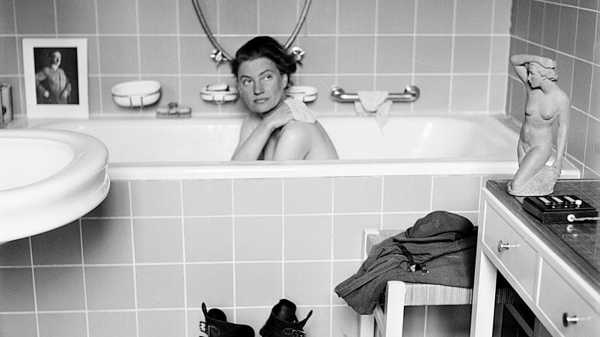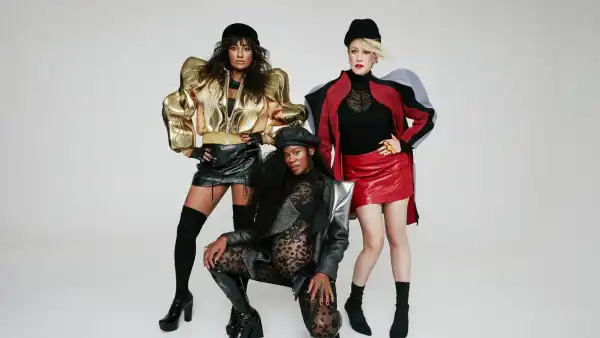
Save this storySave this storySave this storySave this story
On April 30, 1945, the photojournalist Lee Miller took a bath in Hitler’s tub. A correspondent for British Vogue, Miller had posted up in the Führer’s abandoned apartment in Munich along with a group of G.I.s from the 179th Regiment. That morning, she had been among the first to enter the newly liberated Dachau. Her lover at the time, the Life photographer David Scherman, captured her bathing, and in time the picture he took would become famous as a kind of apt visual metaphor for the end of the war. The same day, across Germany in a Berlin bunker, Hitler and his new wife, Eva Braun, took their own lives. In a letter to her Vogue editor, Miller described Dachau’s “great dusty spaces that had been trampled by so many thousands of condemned feet—feet which ached and shuffled and stamped away the cold and shifted to relieve the pain and finally became useless except to walk them to the death chamber.” In Scherman’s photograph, some of that same dust has tracked from Miller’s boots onto Hitler’s white bathmat.
Miller had been photographed many times before, and not just by Scherman. When she was growing up, in Poughkeepsie, New York, her father, an amateur photographer, made a series of frankly sensual portraits of Miller in the nude, a fact that her biographer, Carolyn Burke, deemed “disturbing” but in keeping with his eccentric bohemianism. Later, the story goes, Miller was crossing the street in New York City one day when she almost got hit by a car. The man who helped her up was the publisher Condé Nast. As in a fairy tale, her likeness was soon on the cover of Vogue. She was photographed by Edward Steichen, among many others. There was no word for it then, but she might have been called a supermodel. Eventually, having grown bored of being in front of the camera, she made an impulsive move to Paris with the aim of apprenticing with Man Ray, and she became his muse, his student, and his collaborator. A recent exhibition at Gagosian Gallery, “Seeing Is Believing: Lee Miller and Friends,” contextualized Miller’s photographs alongside the work of artists from her social milieu, including Picasso, Max Ernst, Henry Moore, and the British Surrealist and art historian Roland Penrose, whom Miller married after the war.
Miller became a war correspondent almost by accident. She’d become an accomplished fashion photographer and, on assignment for British Vogue, had made haunting, Atget-like pictures of the London Blitz. But she was itching to get closer to the conflict. In 1944, she was granted accreditation to the U.S. forces as a war correspondent and was sent off to Normandy at Vogue’s behest in her new Savile Row-tailored uniform, which she would wear unceasingly for a year. The powers that be assumed that she would feel at home among nurses, so she was assigned to photograph a U.S. evacuation hospital near Omaha Beach. Her second assignment, in the French port city of Saint-Malo, was supposed to be similarly out of harm’s way. But, owing to an intelligence wire-crossing, shortly after her arrival she found herself in the middle of a full-blown siege.
From then on, Miller was Vogue’s woman on the ground, sending back not only photographs but eloquent, hard-nosed dispatches from the front lines. (Her time covering the war is the central subject of a forthcoming bio-pic, “Lee,” starring Kate Winslet.) She brought an aesthete’s eye to an otherwise unfathomably ugly endeavor, creating pictures that were both profoundly moving and unforgettably discomfiting. In Vienna, she photographed the opera singer Irmgard Seefried in dramatic silhouette, singing an aria from “Madama Butterfly” in the twisted ruins of a bombed-out opera house. In Leipzig, she captured the body of the deputy burgomaster’s daughter, who had died by suicide as the Allied troops advanced, in an image that recalls a Caravaggio painting or Hippolyte Bayard’s “Self Portrait as a Drowned Man.” Miller observed at the time, “The love of death which is the under-pattern of the German living caught up with the high officials of the regime.”
In June, 1945, Vogue published an uncharacteristically brutal collection of pictures that Miller had made at Buchenwald under the blaring headline “BELIEVE IT.” Featuring bodies stacked like cords of wood and a bloated S.S. guard dangling from an iron hook, the spread was an obstreperous incursion among the kind of fashion and perfume ads that Miller had once shot or appeared in. But, even for those, like Miller, who witnessed the Holocaust’s aftermath firsthand, it was difficult to conceptualize the evils that had been perpetrated against the Jews of Europe. During several days in Hitler’s apartment, she went through his cabinets, made note of his monogrammed silver and table linens, and took a stagy photograph of an American serviceman lounging on a daybed, perusing a copy of “Mein Kampf.” Around midnight on May Day, news of Hitler’s death reached them via the BBC. “Well, alright, he was dead,” she wrote to Audrey Withers, British Vogue’s editor at the time.“He’d never really been alive for me until today.” Visiting Hitler’s home, she continued, made him “less fabulous and therefore more terrible, along with a little evidence of him having some almost human habits; like an ape who embarrasses and humbles you with his gestures, mirroring yourself in caricature. ‘There, but for the grace of God walk I.’ ”
Scherman’s photograph of Miller in the tub is not exactly glamorous. She does not seem like one of the prototypical bathing beauties who populate art history, like the one carved in stone, or perhaps cheaply reproduced in plaster, that is sitting on the dressing table to her right. (Miller later offered her withering assessment of the Führer’s collection: “The art work—sculpture, still wearing prize medals from exhibitions on a string—was mediocre, as were the paintings on all the walls.”) She is still beautiful, modestly hunched over and scrubbing her upper back with a washcloth, but she looks tired. At Dachau, that morning, she had photographed piles of bodies in trucks and train cars, which had escaped incineration only because the camp had run out of fuel five days prior; skeletal prisoners still warehoused in their bare bunks, too weak and sick to celebrate their freedom; an S.S. guard, unjustly placid in death, floating in a canal. Only about a third of her negatives from that April morning survived, because Miller visited the Vogue offices and went at many of them with a pair of scissors. A darkroom assistant at the time later recalled Miller saying, “I don’t want anyone to have to see what I witnessed, but I’m leaving enough to make sure there’s no doubt about what happened.”
It’s tempting to cast the photograph of Miller’s bath as a talisman of triumph, a middle finger, a cleansing ritual. With the monster vanquished, the stink of evil can begin to be scrubbed away. But, of course, it doesn’t really work that way. After the war, Scherman recalled in an interview, Miller became a “peacetime casualty,” which is to say that she was swallowed up by despair. She drank. She hid her photographs away in the attic of the country house she shared with Penrose and tried to forget. She never talked about the war. Later, her son, Antony, remembered the shock of discovering his mother’s archive of work, in the attic after her death: “I had known my mum as a useless drunk. A hysterical kind of person who . . . even catching a train in Lewes was a major episode. I could not believe that she was the same person that had created this material.”
Miller’s final act brought a kind of redemption. She began to cook, and, as with all the things she’d grasped onto in her richly variegated life, she pursued her new passion doggedly. She amassed a library of more than two thousand cookbooks. She won cooking prizes. She became a veritable encyclopedia of obscure dishes from around the globe. She threw famous Surrealist dinner parties, featuring strange delicacies like chicken covered in gold leaf. She adored blenders. Frequently, while entertaining a rotating cast of illustrious guests, she would serve food or drinks on a silver platter that she had liberated from Hitler’s famous mountain aerie, near Berchtesgaden. Like the silver in his Munich apartment, the dish was monogrammed with his initials. But, in a note appended to one of her recipes, she recalled that no one seemed to notice. ♦
Sourse: newyorker.com







